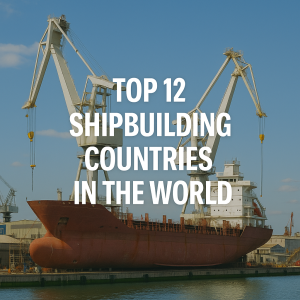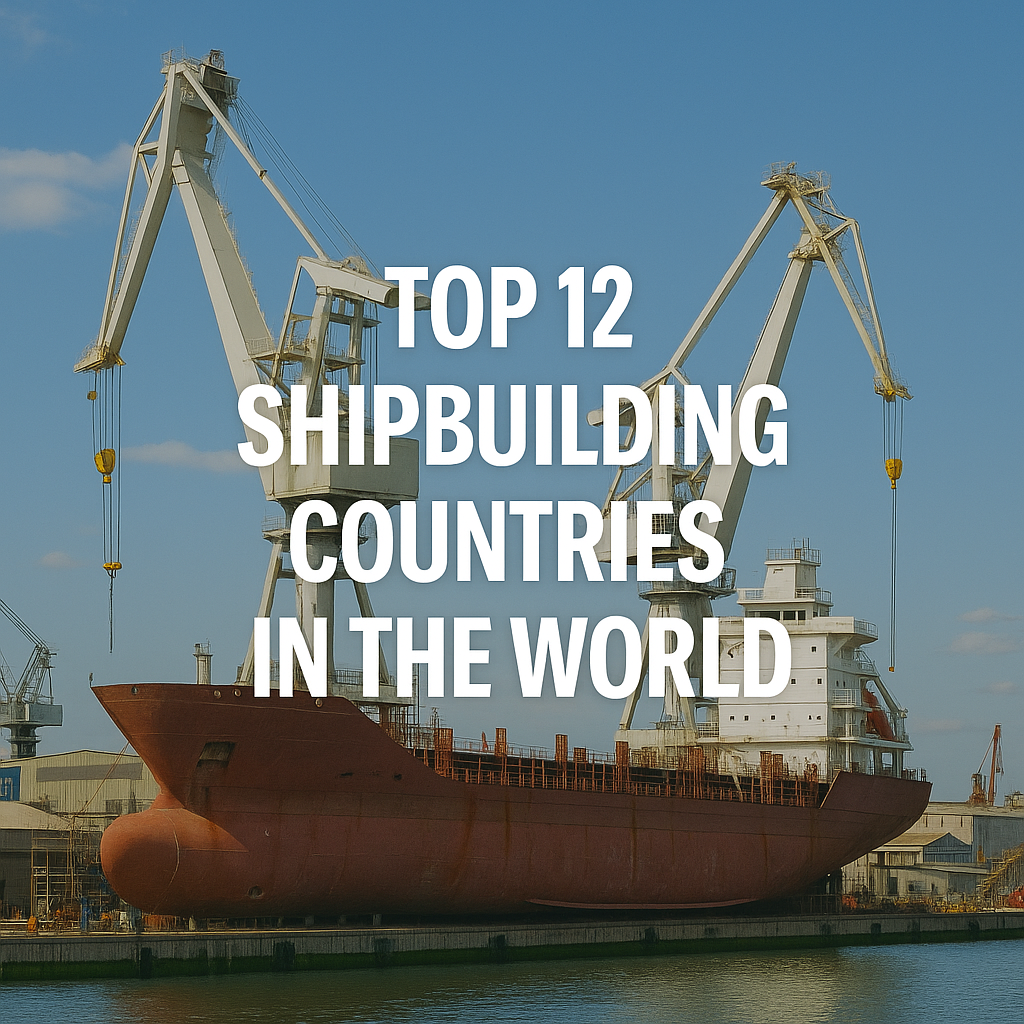Discover the top 12 shipbuilding countries in the world, their innovations, market shares, and strategic roles in global maritime trade. Explore how these nations shape the future of ship design and ocean logistics.
Why Shipbuilding Matters in Modern Maritime Operations
Shipbuilding is the foundation of the maritime industry. Without new vessels—tankers, container ships, LNG carriers, naval ships, and ferries—global trade would grind to a halt. According to UNCTAD (2023), over 80% of world trade by volume is carried by sea, and the demand for advanced, fuel-efficient, and low-emission ships continues to grow.
Shipbuilding is also an indicator of industrial strength, technological capability, and geopolitical influence. The nations leading this sector are shaping not only the world’s maritime fleet but also the pace of innovation in decarbonization, digitalization, and naval defense.
1. China
- Global Share: Over 47% of global shipbuilding output (Clarksons Research, 2023)
- Key Yards: China State Shipbuilding Corporation (CSSC), COSCO Shipyard Group
- Strengths: Massive scale, vertical integration, government subsidies
- Innovation: LNG carrier construction, autonomous ship programs
2. South Korea
- Global Share: Around 28% of global output
- Key Builders: Hyundai Heavy Industries, Samsung Heavy Industries, Daewoo Shipbuilding & Marine Engineering (DSME)
- Specialization: LNG carriers, VLCCs, FPSOs, drillships
- Tech Leadership: Smart yards, hydrogen-ready ships, AI for welding and logistics
3. Japan
- Global Share: Approx. 17% of global output
- Major Companies: Mitsubishi Heavy Industries, Imabari Shipbuilding, Japan Marine United
- Focus: Bulk carriers, car carriers, eco-friendly propulsion
- Challenges: Aging workforce, competition from China/Korea
4. Philippines
- Key Firms: Tsuneishi Heavy Industries, Austal Philippines, Keppel Philippines Marine
- Strengths: Labor force, outsourcing from Japan and Korea
- Specialization: Medium-sized tankers, bulk carriers, passenger vessels
- Emerging Trends: Modular ship assembly and export-focused yards
5. Vietnam
- Notable Yards: Hyundai-Vinashin Shipyard, Ha Long Shipyard
- Profile: Rising shipbuilder in Southeast Asia
- Output: Handymax, Panamax bulkers, oil tankers
- Competitive Edge: Low labor costs, proximity to China
6. Turkey
- Primary Yards: Sedef Shipyard, RMK Marine, Tersan Shipyard
- Focus Areas: Military vessels, ferries, offshore support vessels (OSVs)
- Strengths: Naval design, EU proximity, defense exports
- Recent Growth: Offshore wind and green vessel retrofitting
7. India
- Major Players: Cochin Shipyard, Mazagon Dock, L&T Shipbuilding
- Strategic Role: Naval shipbuilding and coast guard fleets
- Focus: Defense contracts, smaller cargo vessels, inland waterway barges
- Government Support: Maritime India Vision 2030
8. Germany
- Key Builders: Meyer Werft, Lürssen, TKMS (ThyssenKrupp Marine Systems)
- Specialties: Cruise ships, submarines, luxury yachts
- Innovation: Hydrogen and battery-powered cruise liners
- Limitations: High production costs, niche focus
9. Italy
- Notable Firm: Fincantieri
- Specialization: Cruise ships, naval vessels, offshore structures
- Success Story: Fincantieri’s global presence and M&A with Norwegian VARD
- Sustainability Focus: LNG fuel, digital twin ship management
10. France
- Primary Player: Chantiers de l’Atlantique, Naval Group
- Niche: Cruise ships, aircraft carriers, submarines
- Strengths: Defense innovation, international partnerships (e.g., AUKUS)
- Investments: Modular shipbuilding, renewable integration (wind turbine vessels)
11. United States
- Key Yards: Huntington Ingalls Industries, General Dynamics (Bath Iron Works, NASSCO)
- Focus: Naval vessels, LNG tankers, Jones Act-compliant ships
- Challenges: Aging infrastructure, limited commercial sector
- Support: Strong federal contracts, military-focused R&D
12. Russia
- Major Shipbuilders: United Shipbuilding Corporation (USC), Zvezda Shipyard
- Core Markets: Ice-class ships, nuclear-powered vessels, submarines
- Constraints: Sanctions, limited international demand
- Resilience Strategy: Focus on Arctic and military projects

Case Studies in Global Shipbuilding Leadership
Hyundai Heavy Industries: Automation and Smart Yards
South Korea’s HHI developed AI-enabled welding robots and digital planning systems to reduce construction time by 20%. These “smart yards” are a model for future shipbuilding.
Fincantieri: Cruise Ship Dominance
Italy’s Fincantieri has delivered over 100 cruise ships and works closely with global clients like Carnival and Norwegian Cruise Line. It emphasizes digital twin monitoring and hybrid propulsion.
China’s ZPMC: From Shipbuilder to Port Equipment Giant
ZPMC not only builds ships but also dominates the global market for container cranes, proving how Chinese shipbuilders integrate across maritime value chains.
FAQs
1. Which country builds the most ships today? China leads globally, followed by South Korea and Japan.
2. What types of ships are in highest demand? Currently, LNG carriers, container ships, offshore wind support vessels, and dual-fuel ships are in high demand.
3. Why do some countries dominate shipbuilding? Factors include government subsidies, advanced industrial bases, access to raw materials, labor cost advantages, and technological innovation.
4. Are green ships a focus area? Yes. Many nations are investing in LNG, methanol, ammonia, hydrogen fuel, and hybrid-electric propulsion systems.
5. What role do classification societies play? They ensure ships meet safety, environmental, and performance standards. Key players include DNV, ABS, Lloyd’s Register, and ClassNK.
6. Can smaller countries compete in shipbuilding? Yes, particularly in niche markets like luxury yachts, naval vessels, or green retrofits.
7. How is digitalization impacting shipyards? AI, digital twins, 3D modeling, and smart manufacturing tools are improving precision, safety, and productivity.
Conclusion
The top 12 shipbuilding countries are at the core of the maritime industry’s evolution. From Asia’s industrial giants to Europe’s specialized innovators, each nation contributes unique capabilities to a rapidly changing global fleet.
Whether it’s South Korea’s LNG ships, Italy’s cruise liners, or India’s naval platforms, shipbuilding today is a blend of tradition, technology, and transformation.
Call to Action: Stay ahead by tracking maritime innovations through IMO updates, shipyard announcements, and industry research. For aspiring professionals, consider careers in naval architecture, marine engineering, or classification society compliance.
References
- UNCTAD. (2023). Review of Maritime Transport. https://unctad.org
- Clarksons Research. (2023). Global Shipbuilding Statistics and Market Shares. https://www.clarksons.net
- Lloyd’s List Intelligence. (2023). Shipbuilding Country Rankings. https://lloydslist.maritimeintelligence.informa.com
- International Maritime Organization (IMO). (2023). Decarbonization Roadmap. https://www.imo.org
- DNV. (2023). Alternative Fuels Insight Platform. https://afip.dnv.com
- IHS Markit / S&P Global. (2023). Global Marine Trends. https://ihsmarkit.com
- Fincantieri. (2024). Sustainability Reports and Global Strategy. https://www.fincantieri.com


I like the helpful info you provide in your articles.
I will bookmark your blog and check again here frequently.
I’m quite certain I will learn lots of new stuff right here!
Best of luck for the next!
Nice post. I used to be checking constantly this weblog and I am
inspired! Very useful info specially the closing part 🙂 I
handle such info a lot. I was seeking this particular info for a very lengthy time.
Thanks and best of luck.
Hello, I think your website might be having browser compatibility issues.
When I look at your website in Firefox, it looks fine but when opening in Internet Explorer, it has some overlapping.
I just wanted to give you a quick heads up! Other then that, awesome blog!
Greetings from Idaho! I’m bored at work so I decided to check out your
site on my iphone during lunch break. I love the knowledge you present here and can’t wait to take a
look when I get home. I’m surprised at how fast your blog loaded on my phone ..
I’m not even using WIFI, just 3G .. Anyways, wonderful site!
It’s great that you are getting thoughts from this paragraph as well as from our dialogue made at this place.
Hi, i think that i saw you visited my web site thus i came
to “return the favor”.I’m trying to find things to enhance
my site!I suppose its ok to use some of your ideas!!
We are a group of volunteers and opening a new scheme
in our community. Your website provided us with valuable info to work on. You’ve done a formidable
job and our whole community will be thankful to you.